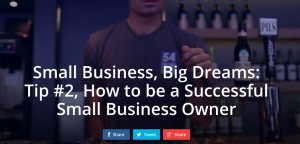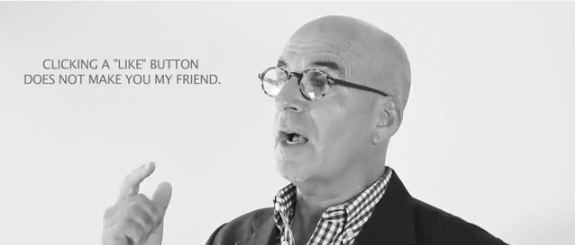Ted Rubin and I “met” back in 2010 via social media and Ted’s extraordinary personality and commitment to establishing and maintaining connections is what has made him who he is today. His “Return on Relationship” theory of engaging in a more personal way in ALL aspects of our lives has become one influential message that is quickly becoming a beloved belief. Ted’s amazing ability to connect and influence is well-deserved and I appreciate his time with me in answering some questions for Simple Bliss Mag.
 Ted Rubin
Ted Rubin
Customers to Brands: #WSILTY (Why Should I Listen To You?)
The words “customer experience” and “engagement” are being bandied about a lot lately, and new tools are being created every day to supposedly help brands bridge the gap between engagement and sales. But let’s not get the cart before the horse. Before you go out and spend money on the next big CEM or SaaS tool, there are two basic principles you need to work on:
- A Deep Understanding of Your Audience
- A Crystal-Clear Value Proposition
If this sounds like Marketing 101 to you, well, you’re right. But you’d be surprised how many brands throw these tried and true principles out the window in favor of the next “big idea.” After all, this is a new era, right? Isn’t exploding technology turning marketing on its head?
Yes and no. It’s true that we’re charting new ground when it comes to social connection and engagement, and technology is changing so fast it’s hard to keep up. In this environment it’s easy to feel you’re getting left behind; however, the truth is that we’re all people being carried by the same current. Rather than desperately grasping at every new tool that floats by, it pays to do something counter-intuitive: relax, observe and think.
Who is your audience (really)?
Today’s technologies allow us a myriad of ways to listen to our audiences and learn about their pains, passions and preferences. But do we do it? Not as well as we should. We get caught up in “big data,” but don’t often look deeper. Take a leaf from the old-school books on direct response marketing and spend quality time listening to what your audience has to say. Where do they hang out? What are their dreams? What are their problems? How do they live, play and work? What are the social issues that matter most to them? Unlike the “focus group” marketing of yesteryear, social platforms have brought this type of listening to a whole new level if we’ll just use them.
I’ve talked before about manually digging into people’s social profiles to learn more about them. When brands direct more resources to this type of listening, they gain much greater understanding of their customers and prospects as individuals with hopes, dreams and everyday problems. It’s this knowledge that helps them scale connectivity and engagement, and allows them to create the memorable experiences their audience wants to share.
Why should your audience listen to you?
Today’s consumer is busy, distracted and a little overwhelmed with technology, so once you get to know them, spend time thinking about how you help them. If we spent more time asking ourselves “How can I help?” rather than “How can I sell?” we would be a lot better off.
What makes your brand special? What is it about what you offer (or the way you offer it) that makes people sit up and take notice? Better yet, what makes their experiences with your brand unique? When you know your audience well enough to understand their motivations and empathize with them, it’s much easier to distill your unique value proposition. Having a crystal-clear vision of your value helps your brand in two ways. It helps you create content that will attract your audience, and gives your employees a mission standard for ensuring that all experiences with your brand are exceptional.
Listening to your audience and using what you learn to develop a clear mission and value statement will help you put strategy before tactics—a big advantage in a rapidly changing environment. So before jumping at the next tactic in the technology stream, make sure you are using the tools you already have to answer the #WSILTY question first.
Why ABC “Always Be Closing” Needs to Change
You’ve heard the words behind the ABC acronym before – Always Be Closing, as the popular interpretation goes. For some, it’s a mission statement, even a way of life. But what does it really mean? All of the emphasis in this version of ABC points to closing. The sale is the end-all of the entire marketing interaction, and everything else is secondary, if it registers at all. Close one deal, don’t look back, and move right along to the next one. As long as the cycle keeps churning, everyone’s happy… right?
Why the Best Marketers MUST Embrace Social
From the simplest to understand perspective… the socially nimble company tasks its employees with “opening their listening ears” and tapping into community intelligence (both the company’s and the employee’s communities), then acting on what they’ve learned. This can put you in a much better position than your competitors in two ways: 1) getting a well-focused product to market much faster, and 2) earning a higher level of marketplace trust and identification with your brand.
My Three Favorite Blogging Tips
#1: User-Friendly Navigation: Keeping your blog easy to navigate with intuitive category labels will help people find the information they seek much faster. Also, make it easy for readers to leave comments and share your posts on various channels that will help lead others back to you.
How to Build a Relationship-Driven Company Culture ~via @MarketingScope
How to Build a Relationship-Driven Company Culture ~via @MarketingScope
What’s the one thing that’s lacking in business culture today that has the potential to bring in more revenue than anything else? I’ll give you one word: trust. It’s not something you can buy with advertising dollars. It has to be earned through the actions of the people in your company, from the executive office all the way to the mailroom. Unfortunately, many people seem to have forgotten the impact that this little 5-letter word (or lack of it) has in their personal and business relationships.
I’ll give you a recent example from LinkedIn — the generic LinkedIn request to connect, followed closely by a sales pitch. I’m sure you’ve received some of those, right? Who hasn’t? Now I’m not objecting to the connection request—after all, LinkedIn is for connecting. Maybe they’re new to the platform and don’t know how to personalize a connection request, maybe they made the mistake of using the mobile app which for some reason doesn’t allow for a personal note. That’s understandable. But connecting with someone just to pitch them (without building a relationship first and developing trust) is inexcusable.
I posted my “new reply” to those types of pitches on Facebook, and it goes like this:
“So you connected in order to simply pitch me… not even a hello, how are you, buy me a cocktail before propositioning me? You don’t even know me, sent me a generic connection request, then when I open the door for you, instead of shaking my hand and getting to know me… you come right out with a sales pitch.
Seriously??? Dude… time to get some relationship building game. Good luck on your next pitch… not interested. Make it a great weekend. “
The post received 42 comments and over 211 likes, and virtually every commenter was in solidarity with me—many having had the same experience.
I don’t know a single person who likes to get pitched via social (or any communication channel) before a relationship is established. Do you? Yet we see this all the time—especially from sales people more interested in meeting quota than doing the work of building rapport.
Rajesh Setty, co-founder and President at WittyParrot, illustrates this concept in his LinkedIn post entitled “The Forgotten Art of Asking Right.”
He hits the nail on the head with this post, using an ingenious, color-coded “Request Spectrum” illustration of the four zones of relationship maturity and where it may (or may not) be conducive to ask for something.
Zone 1 is where you first meet, and the illustration shows the trust-building track along the relationship as you get to know the person, develop rapport, etc.
In my opinion, Raj’s spectrum should be required reading for any sales or marketing class, and it should be built into every organization’s employee guidebook.
Are there some people that will ignore it anyway? Sure. There are lots of folks out there who could win awards on pissing off their co-workers, alienating customers and driving away prospects. It’s a personality thing. However, if more companies ask the right questions on interviews, they could weed out those potential employees who will never “get it.” And by actively teaching this concept to current employees and making it integral to company culture, organizations could scale their relationship-building capabilities both inside and outside the company via both face-to-face meetings, and especially via digital and social channels.
However, I also think that companies must do a better job of building trust with their employees. It’s a two-way street. The key lies in revamping the employee-employer relationship. Employers have to understand that the “buyer’s market” they’re in right now will not always be the case, and even if it is, that attitude is no way to build brand loyalty that can go well beyond time on the job. If you want to build a winning team that stays with you, advocates for you and helps you get ahead as a company, you have to treat that team with respect. Treating employees like a commodity and/or a cost center eventually backfires because it leads to constant turnover, which is counterproductive in the long term.
Another way employers can build and nurture this type of culture is byempowering their employees and recognizing the fact that social connection is an integral part of all of our lives now. Remember that in today’s social world, every person has an extended circle of personal influence and an opportunity to build their own personal “brand.” By helping your employees build that brand rather than squelching individuality, you could build an army of very powerful advocates. Most people, when given the opportunity will advocate for their brands, when they feel good about where they work.
Start thinking of your employees as an investment instead. If you look out for them and help them when they need it, they’ll be there for you when you need them. It can be as simple as creating a nurturing workplace that encourages growth and innovation, versus a culture of fear fostered by so many companies today.
Maybe we can’t teach everyone how to #JustBeNice, but we can definitely do a better job of building trust with our employees and teaching them to do the same with co-workers, vendors and customers.
Most Brands Don’t Look People in the Eye Digitally on Facebook ~@Progressive

ttps While I can name several big brands that are killing it on Twitter for relationship building and engagement, I don’t think I’ve actually seen one that’s getting Facebook right. Sure, they invest quite a bit in making their business pages look great—they might even have a powerful content strategy for posting and curating things their audience finds valuable, and an ad budget to boot! But the one thing that all brands could be doing better on Facebook has nothing to do with cranking out more content or spending more money on ads—it’s developing a one-on-one strategy.
Let’s Concentrate on Learn-Learn vs Win-Win
My friend Niklas Myhr, the “Social Media Professor,” recently blogged about something I’m very passionate about, Social Media and Quality Management. In his post he discusses tapping your social advocates early on in the product and/or service development phase, listening to what they have to say and learning more about what they want and how you can deliver it to them.
How to Build a Mobile Community
Building a mobile community is the same as building any community… engage, interact, add value and show support for the group and what is important to them. In today’s digital world it’s all too easy for us as brands and individuals to let our relationship-building muscles atrophy. We get caught up in a multitasking whirlwind of emails, social updates and text messages where it’s easy to let a connection or a conversation fall through the cracks. We’re super-connected, yet somehow disconnected at the same time. This puts us at risk of losing the very relationships that help us prosper as companies and people.
Reinvigorating the Lost Art of Conversation ~@Progressive
Our words reveal our refinements; they tell the discerning listener of the company we have kept; they are the hallmarks of education and culture. – Dale Carnegie




